Tips for Building Your Next Small Accessory Structure
Dreaming of a quiet office space just steps from your home? Want to move mom close but not inside your home? Ready for a backyard entertainment space? Small accessory structures, separate from your main dwelling, are quite popular in Williamson County. If you’ve been thinking about building one of these versatile structures but don’t know where to begin, these key considerations will help you understand where to start.
First, some definitions:
Shed: A structure primarily used for storage. Unfinished interior with exposed studs, rafters, and sub floor. Electrical is sometimes added, plumbing is not included.
Accessory Dwelling Unit (ADU) / Casita / Home office: Though they have different names – usually assigned based on intended use – these structures are fully finished with insulation, wall coverings, flooring, HVAC, electrical, and sometimes plumbing.

1. Are you allowed to build an ADU on your property?
Outside city limits, no HOA/POA – usually yes. Check your property survey for any easements, building setback lines, or other restrictions regarding building placement.
Outside city limits, inside a neighborhood HOA/POA – it depends. Check with your HOA. One large, local, master-planned community requires sheds to be no taller than 8′, while it allows ADUs to be over 11′ tall! Typically, you’ll want a roof height of at least 10′ to provide a comfortable indoor space.
Inside city limits – you will need to check with the city to see if ADUs are allowed in your neighborhood. Cities are concerned about overall size, height, access, and permits. Yes, you will have to obtain permits when building inside city limits.
2. Do you have enough power?
ADUs typically need 60-100 amps of electrical power. An electrical inspection will determine if you have ample capacity to handle this additional load.
If you don’t have enough power, you will need to upgrade your service.
3. What about a bathroom?
If you’re on a septic system, then you need to consider if you are adding load or just shifting it from using a bathroom in the house to the new building. Any septic changes are governed by a permit from the county.
If you’re on a sewer system, then you’ll tie the ADU wastewater into the sewer. Depending on where that drainpipe is located on your property, that can entail trenching through much of your property to make the connection.
Fresh water will also have to be routed from an accessible location on your property to the new building.
4. What is your budget?
If you have the space and clearance to build an ADU, then you need to look at a budget.
A basic backyard office/workshop/hobby space is going to start around $30,000.
A complete one-bedroom, one- bath casita with a kitchen is going to be pushing $150,000, if not more, depending on driveways, masonry, electrical, and plumbing connections.
Whatever name you give your dream building, tackle these steps and you’ll be on the way to realizing your dream and hearing, “It’s move-in day!”
Moore Liberty Buildings • MooreLibertyBuildings.com • 512-548-6474
